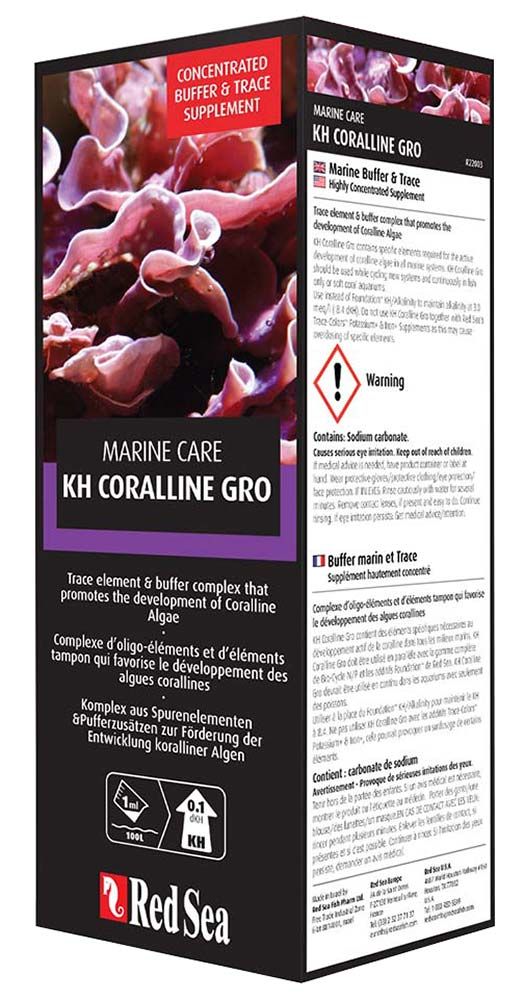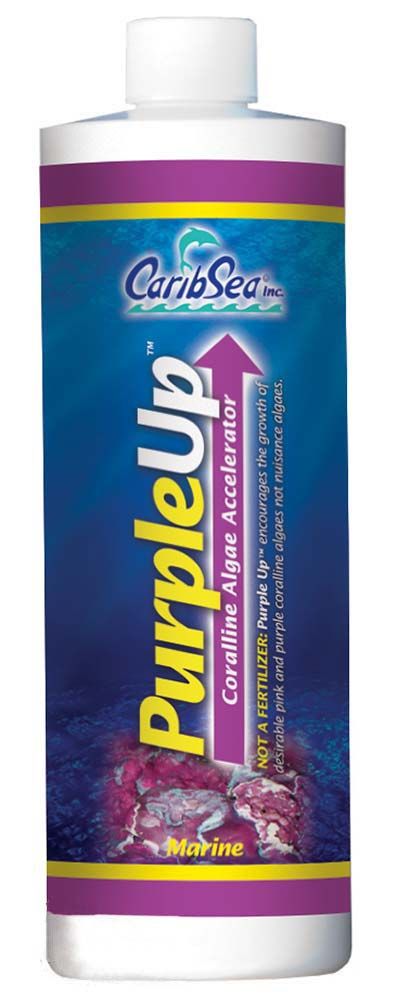When most people think of algae, they think of nuisance algae like hair or brown algae. These can be a pain and create a less than appealing display in your aquarium. However, Coralline Algae is like those other algae species. Coralline Algae is actually a beneficial alga to your aquarium, so unlike other algae, it is important to facilitate Coralline Algae growth.
The algae do a lot of helpful things for your aquarium, like compete against bad kinds of algae, benefit water chemistry, and creates a very pretty display. Your aquarium will certainly be helped by including Coralline Algae, but it’s important to understand what it is and how to promote its growth.
Will Coralline Algae grow on its own?
Growing Coralline Algae is really easy, but there is a catch; Coralline Algae growth won’t happen on its own in your reef aquarium. It first needs to be introduced by you in some way. Thankfully, there are several methods available to make this a painless process.
- Coralline Algae in a bottle
- Introduce live rock to your reef aquarium that already has a community of Coralline Algae growing on it.
- Find a friend or, if you are on good terms with them, ask your local pet store if you can have a bit of a sample of the Coralline Algae in their reef aquarium. All you need to do is take some scraps from the Coralline Algae with a razor blade or similarly sharp object to gather the samples.
You should consider trying to do all of these things if you want to have a diverse Coralline Algae community in your tank. The more Coralline Algae species present in your reef aquarium means that more will be growing in your aquarium.
How long does it take for Coralline Algae to grow?
Growing Coralline Algae is super simple once you know the tricks to it, but depending on the method, Coralline Algae will grow at different rates. For instance, if you are focusing on trying the bottled spore method, it will depend on the manufacturer and how well that bottle was treated during transportation. It can also depend on the conditions of your reef tank. How is the light? What spectrum color are you using? What are the Calcium Carbonate levels of your reef tank? These things will help to determine the rate of your Coralline algae growth.
However, on average, you can expect to see growth between 4-8 weeks from when you began seeding. Play around with the lighting to see what might benefit the Coralline Algae but make the adjustments slowly so as not to stress your creatures, coral, or algae in your aquarium.
How do you increase Coralline Algae growth?
You can try to encourage Coralline Algae growth by turning off your filters and skimmers once the Coralline Algae have been introduced. Don’t worry, the equipment will be off for an hour tops; if you are worried, set a timer on your phone so you don’t forget to turn your devices back on.
Keep your powerheads running while you carefully scrape off bits of the Coralline Algae into the tank. The powerheads should mix the water up and spread the Coralline Algae throughout your tank. These scrapings will take to different parts of your tank and continue to grow. Remember to turn your back on when some time has elapsed!
What might be even easier is if you are able to remove the live rock that has the algae growing on it, you will be able to more easily scrape the algae pieces.
- Remove the live rock and place it on your work surface and grab a paring knife, scalpel, or another sharp object that will be able to scrape the spores off your life rock. Put down plastic or aluminum foil, just something to help catch the pieces of Coralline Algae that you are scraping off. Once you think you have scraped enough of the spores off the live rock, gather them up into a small dixie cup for use shortly.
- Next, gather the following ingredients, which will be used to mix with the algae: half a Table Spoon of Calcium, 2 ml syringe of Magnesium, 2 cups of water from your sump or tank, and a blender.
- Next, add your water to the blender and then mix the Calcium into the water.
- Add the Magnesium to the blender.
- Finally, quickly mix up the spores and add them to the blender as well
- Start the blender. The goal is to make the spores as fine as possible in the blender. Once all the big chunks are gone, you should be good to go.
- Now slowly pour the concoction into a high flow area so the contents can more easily disperse around your tank.
Now your tank is properly seeded with the various algae spores. You might have even been able to see how quickly the Coralline Algae spores spread through the tank after they were placed in front of the powerhead.
Does Coralline Algae in a bottle work?
That depends as the different Coralline in bottle products can vary as much as individual tanks can. What that means is that your best friends might have had great success with their algae in a bottle, while your reef tank might not tank to it at all.
If you are dead set on getting your Coralline Algae to grow, the bottled spores might be a great backup plan but using spores from live rock or an active community is your best bet for results.
Does Coralline Algae need light?
Like other kinds of algae, Coralline Alage does need light in order to thrive, but how much light it needs will vary depending on the specific species of Coralline Algae. Coralline Algae will grow under only a little light, but you shouldn’t restrict yourself to only dim lights to quickly grow this alga. It can and will grow under a variety of light intensities, but you may need to experiment within your tank’s inhabitants’ parameters in order to see what level of light will be best for your species of Coralline Algae.
Why does Coralline Algae turn white?
The first thing that you should always check is to see if the water parameters are within acceptable ranges. If they are off, the algae (and the other organisms in your tank) will have adverse effects. If the water quality is off, begin to remedy it and save your community of Coralline Algae encrusted live rock in your reef tank. If your water parameters appear fine, it might be caused by the lighting in your reef aquarium.
Coralline is distinct from other algae due to its encrusting nature and pleasant color. It is able to do this with Calcium to aid in the encrusting process and light to facilitate the color. When one of those ingredients is lacking in your tank, there is the potential that your Coralline Algae won’t thrive in your reef tank.
If your algae are turning white, the most probable answer is due to light shock. Light shock is caused by a drastic change in the lighting conditions resulting in shock to the organism. If the lighting conditions changed for even a short period, there is a possibility that algae will bleach. This process can happen really quickly, so don’t be surprised if a timelapse of only 30 minutes is enough to encourage the change.
Why is my coralline algae disappearing?
If you notice that your algae are beginning to disappear, there can be a number of culprits responsible. First, you will want to check to see if your water is within the algae’s average parameter requirements. Specific gravity should be somewhere between 1.024; phosphates should be close to zero while Nitrates are at 5 ppm at most. Are the Calcium levels within the 350 – 480 ppm range? If these parameters are within acceptable parameters, then you might have a creature in your tank that is snacking on your algae.
There are a few common marine species that will depend much on Coralline Algae in your tank. Here are a few of the most likely culprits.
- Crabs
- Snails
- Sea Urchins
If you have one of these kinds of creatures living in your tank’s environment, then you might want to monitor their behavior to confirm if they are truly responsible. If your marine life is responsible for the loss of algae, you have a few choices to deal with this issue. First, you can try to make your Coralline Algae grow faster than the rate at which your aquarium life is eating it. That might be tricky depending on the rate of consumption, but you can follow the tips in the above sections to outpace the critters.
You can also try to supplement the species diet with additional flakes or pellets to make them fuller more often. This will hopefully reduce the number of algae that the creature is eating on average.
Finally, if you are really attached to the look of Coralline Algae, you might consider finding a new home for your Coralline eating critter. If your sump is set up effectively, you might even rehome them there. However, make sure that you are prepared to meet the creature’s needs while they are in the sump. That means supplying an adequate diet and water quality.
Do you need Coralline Algae?
Coralline Algae doesn’t just provide your reef tank with a neat aesthetic; it also helps facilitate the production of useful chemicals that other creatures in your reef tank need to thrive!
What is Coralline Algae?
Coralline Algae is an alga with a light reddish color and loves to grow on live rock. This alga won’t randomly show up in your reef aquarium like green hair or brown algae. Coralline Algae needs to be brought in by you purposefully. Many aquarists try to introduce Coralline Algae to their tanks to help cover the surface of their live rock with the algae’s pinkish color. However, the color can range from a deep purple to a light red.
It helps to bring a different color palette to the aquarium while at the same time removing growing space for other kinds of nuisance algae. In fact, Coralline Algae will out-compete more pesky species of algae for nutrients and space. Not only does this species of algae give your aquarium a makeover, it quietly helps to reduce the abundance of other kinds of nuisance algae.
Final thoughts
Now you should have a solid foundation for how Coralline Algae benefits your aquarium. From its ability to control many species of algae from taking over your aquarium to its water chemistry benefits to its aesthetically pleasing colors, Coralline Algae does quite a lot for something that is often labeled as simply a nuisance.
Coralline Algae is simple to grow once you know how just make sure you are monitoring your tank’s lighting and water parameters like normal and there should be few issues.



